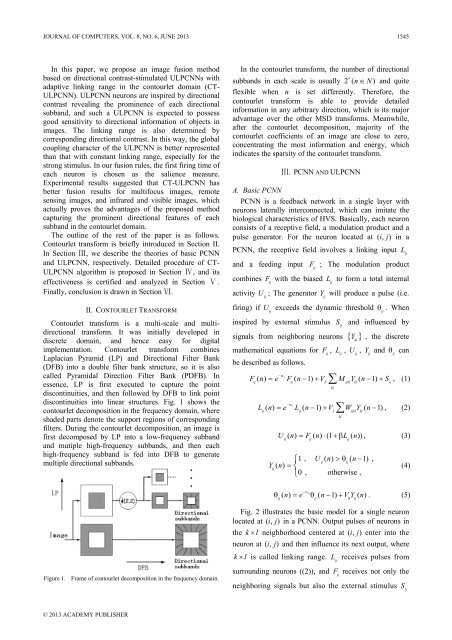Download Full Issue in PDF - Academy Publisher
Download Full Issue in PDF - Academy Publisher
Download Full Issue in PDF - Academy Publisher
You also want an ePaper? Increase the reach of your titles
YUMPU automatically turns print PDFs into web optimized ePapers that Google loves.
JOURNAL OF COMPUTERS, VOL. 8, NO. 6, JUNE 2013 1545<br />
In this paper, we propose an image fusion method<br />
based on directional contrast-stimulated ULPCNNs with<br />
adaptive l<strong>in</strong>k<strong>in</strong>g range <strong>in</strong> the contourlet doma<strong>in</strong> (CT-<br />
ULPCNN). ULPCNN neurons are <strong>in</strong>spired by directional<br />
contrast reveal<strong>in</strong>g the prom<strong>in</strong>ence of each directional<br />
subband, and such a ULPCNN is expected to possess<br />
good sensitivity to directional <strong>in</strong>formation of objects <strong>in</strong><br />
images. The l<strong>in</strong>k<strong>in</strong>g range is also determ<strong>in</strong>ed by<br />
correspond<strong>in</strong>g directional contrast. In this way, the global<br />
coupl<strong>in</strong>g character of the ULPCNN is better represented<br />
than that with constant l<strong>in</strong>k<strong>in</strong>g range, especially for the<br />
strong stimulus. In our fusion rules, the first fir<strong>in</strong>g time of<br />
each neuron is chosen as the salience measure.<br />
Experimental results suggested that CT-ULPCNN has<br />
better fusion results for multifocus images, remote<br />
sens<strong>in</strong>g images, and <strong>in</strong>frared and visible images, which<br />
actually proves the advantages of the proposed method<br />
captur<strong>in</strong>g the prom<strong>in</strong>ent directional features of each<br />
subband <strong>in</strong> the contourlet doma<strong>in</strong>.<br />
The outl<strong>in</strong>e of the rest of the paper is as follows.<br />
Contourlet transform is briefly <strong>in</strong>troduced <strong>in</strong> Section II.<br />
In Section Ⅲ, we describe the theories of basic PCNN<br />
and ULPCNN, respectively. Detailed procedure of CT-<br />
ULPCNN algorithm is proposed <strong>in</strong> Section Ⅳ, and its<br />
effectiveness is certified and analyzed <strong>in</strong> Section Ⅴ .<br />
F<strong>in</strong>ally, conclusion is drawn <strong>in</strong> Section Ⅵ.<br />
II. CONTOURLET TRANSFORM<br />
Contourlet transform is a multi-scale and multidirectional<br />
transform. It was <strong>in</strong>itially developed <strong>in</strong><br />
discrete doma<strong>in</strong>, and hence easy for digital<br />
implementation. Contourlet transform comb<strong>in</strong>es<br />
Laplacian Pyramid (LP) and Directional Filter Bank<br />
(DFB) <strong>in</strong>to a double filter bank structure, so it is also<br />
called Pyramidal Direction Filter Bank (<strong>PDF</strong>B). In<br />
essence, LP is first executed to capture the po<strong>in</strong>t<br />
discont<strong>in</strong>uities, and then followed by DFB to l<strong>in</strong>k po<strong>in</strong>t<br />
discont<strong>in</strong>uities <strong>in</strong>to l<strong>in</strong>ear structures. Fig. 1 shows the<br />
contourlet decomposition <strong>in</strong> the frequency doma<strong>in</strong>, where<br />
shaded parts denote the support regions of correspond<strong>in</strong>g<br />
filters. Dur<strong>in</strong>g the contourlet decomposition, an image is<br />
first decomposed by LP <strong>in</strong>to a low-frequency subband<br />
and mutiple high-frequency subbands, and then each<br />
high-frequency subband is fed <strong>in</strong>to DFB to generate<br />
multiple directional subbands.<br />
In the contourlet transform, the number of directional<br />
n<br />
subbands <strong>in</strong> each scale is usually 2 ( n∈ N)<br />
and quite<br />
flexible when n is set differently. Therefore, the<br />
contourlet transform is able to provide detailed<br />
<strong>in</strong>formation <strong>in</strong> any arbitrary direction, which is its major<br />
advantage over the other MSD transforms. Meanwhile,<br />
after the contourlet decomposition, majority of the<br />
contourlet coefficients of an image are close to zero,<br />
concentrat<strong>in</strong>g the most <strong>in</strong>formation and energy, which<br />
<strong>in</strong>dicates the sparsity of the contourlet transform.<br />
Ⅲ. PCNN AND ULPCNN<br />
A. Basic PCNN<br />
PCNN is a feedback network <strong>in</strong> a s<strong>in</strong>gle layer with<br />
neurons laterally <strong>in</strong>terconnected, which can imitate the<br />
biological characteristics of HVS. Basically, each neuron<br />
consists of a receptive field, a modulation product and a<br />
pulse generator. For the neuron located at ( i, j ) <strong>in</strong> a<br />
PCNN, the receptive field <strong>in</strong>volves a l<strong>in</strong>k<strong>in</strong>g <strong>in</strong>put L ij<br />
and a feed<strong>in</strong>g <strong>in</strong>put F ; The modulation product<br />
ij<br />
comb<strong>in</strong>es F with the biased L to form a total <strong>in</strong>ternal<br />
ij<br />
ij<br />
activity<br />
U ; The generator Y<br />
ij<br />
ij<br />
will produce a pulse (i.e.<br />
fir<strong>in</strong>g) if U ij<br />
exceeds the dynamic threshold θ ij<br />
. When<br />
<strong>in</strong>spired by external stimulus S ij<br />
and <strong>in</strong>fluenced by<br />
signals from neighbor<strong>in</strong>g neurons { Y kl<br />
}<br />
mathematical equations for F ij<br />
,<br />
L ,<br />
ij<br />
, the discrete<br />
U , Y and θ can<br />
ij ij<br />
ij<br />
be described as follows.<br />
−α<br />
F ( n) = e F ( n− 1) + V M Y ( n 1) S<br />
F<br />
ij ij F ∑ − + , (1)<br />
ijkl kl ij<br />
kl<br />
−αL<br />
L ( n) = e L ( n− 1) + V W Y ( n 1)<br />
ij ij L∑ − , (2)<br />
ijkl kl<br />
kl<br />
U ( n) = F ( n) ⋅ (1 +β L ( n))<br />
, (3)<br />
Y ( n)<br />
ij<br />
ij ij ij<br />
1, U ( n) >θ ( n−1),<br />
ij<br />
ij<br />
0 , otherwise ,<br />
= ⎧ ⎨ ⎩<br />
(4)<br />
θ ( n) = e −α θ<br />
θ ( n− 1) + VY ( n)<br />
. (5)<br />
ij ij θ ij<br />
Figure 1. Frame of contourlet decomposition <strong>in</strong> the frequency doma<strong>in</strong>.<br />
Fig. 2 illustrates the basic model for a s<strong>in</strong>gle neuron<br />
located at ( i, j ) <strong>in</strong> a PCNN. Output pulses of neurons <strong>in</strong><br />
the k× l neighborhood centered at ( i, j ) enter <strong>in</strong>to the<br />
neuron at ( i, j ) and then <strong>in</strong>fluence its next output, where<br />
k× l is called l<strong>in</strong>k<strong>in</strong>g range. L ij<br />
receives pulses from<br />
surround<strong>in</strong>g neurons ((2)), and F ij<br />
receives not only the<br />
neighbor<strong>in</strong>g signals but also the external stimulus S ij<br />
© 2013 ACADEMY PUBLISHER
















